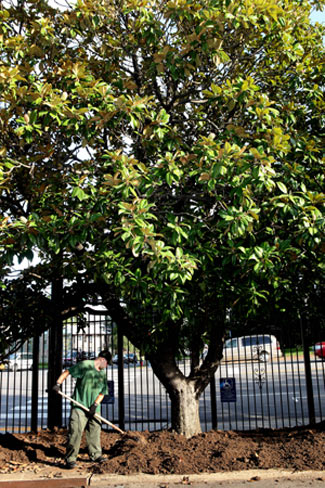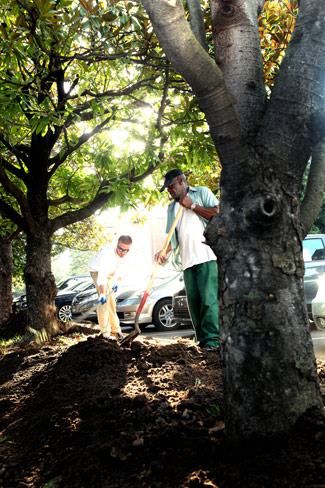The Vanderbilt campus is home to more than 7,500 trees – that adds up to a lot of leaves. But did you know that Vanderbilt Plant Operations’ grounds program has been harnessing nature’s own processes to help trees on campus weather the record heat this summer?

Mulching the areas underneath the trees with compost made from fallen leaves is a key part of maintaining ecological balance on campus from season to season. Refurbishing this ground layer with the right material and in a timely manner also takes advantage of recent rains.
“The basic ingredients come from the Vanderbilt trees themselves, but it takes a sustainable approach to capture the full benefit,” explained Bill Randles, turf and facilities manager for Plant Operations.
There is a distinction between mulch and compost. Mulch retains moisture and buffers the root zone of the tree. It does not undergo the optimum biological breakdown into nutrients that supports the soil’s food web of living organisms the way that compost does. The organic matter and diverse species of beneficial microorganisms found in compost reinvigorate the roots in ways often missing in urban soils. The symphony of life in the soil is rejuvenated to support healthy plant growth.
Vanderbilt’s grounds department applies the same principles on display at the small compost demonstration area behind The Commons Center to the huge pile of leaves stockpiled at Natchez Trace. This massive pile of leaves, accumulated over years, is transformed into compost and spread across campus planting beds. It creates an insulating layer that is especially needed during drought conditions, which are on the rise across the United States. Compost also remains porous, thus taking advantage of the recent rains by retaining ground moisture once water soaks under the nutrient-filled layer.

Suffusing oxygen into the compost pile’s mass of leaves is a key factor in hastening their decomposition into ripened compost. The enormous single pile of leaves is configured into a 90-foot row about 7 feet high. This arrangement allows Plant Operations staff to turn the pile with a front-end loader to expose all layers to oxygen. The compost is carefully monitored each week to check for temperature and moisture content. Curing produces a good deal of heat. When the pile’s internal temperature approaches 150 degrees Fahrenheit, it is flipped and watered to let cure for another month or so. This process is repeated until the temperature decreases to about 90 F and the smell of the compost is rich and earthy.
The results of this effort were recently put to use, when the rich, dark compost was loaded into trucks and delivered across campus to be spread under the trees that shed those same leaves several seasons ago.
“This is a key step toward the ongoing goal of rebuilding the soil structure in campus beds,” said Laura Barker, horticultural specialist with Plant Operations. In the years to come, a portion of each fall’s crop of leaves will continue to be shredded with mowers and spread thinly on top of the aging compost to avoid creating a density too thick for the necessary soil ventilation and oxygen exchange to occur.
Removing leaves from lawn areas across campus is necessary to ensure that sunlight reaches the grass. The larger effort each autumn will be to shred some leaves finely enough to fertilize our lawns without shading out the grass; to shred some onto bed areas under trees; and to haul a large supply of leaves to the Natchez Trace composting operation. This practice keeps the life cycle in balance: It renews the vigor of campus soil in beds beneath trees for future generations, while decreasing storm water runoff and practicing water conservation by reducing the need for irrigation.
“This is as green as it gets (in terms of) staying in balance with nature,” said Mark Petty, assistant vice chancellor of plant operations.
For more information on Vanderbilt’s sustainability efforts, visit the SustainVU website.
Contact: Judson Newbern, (615) 322-2715
judson.newbern@vanderbilt.edu